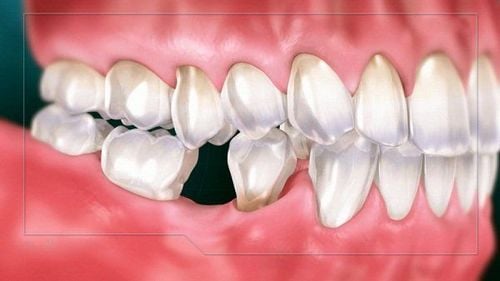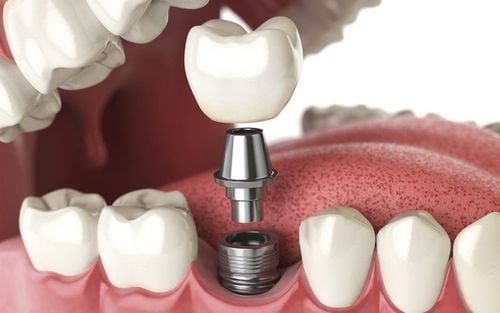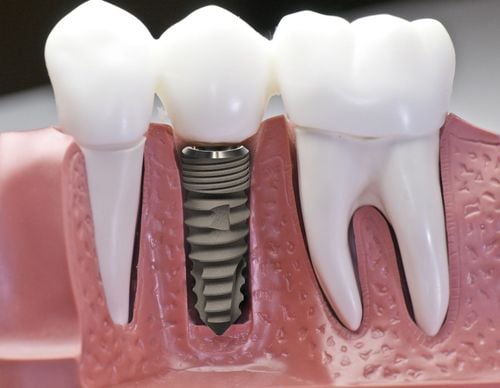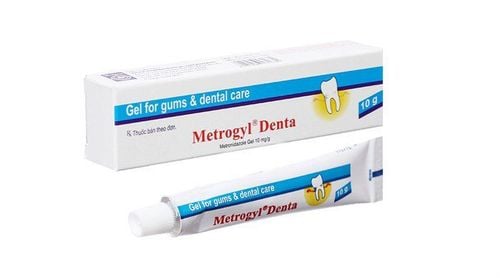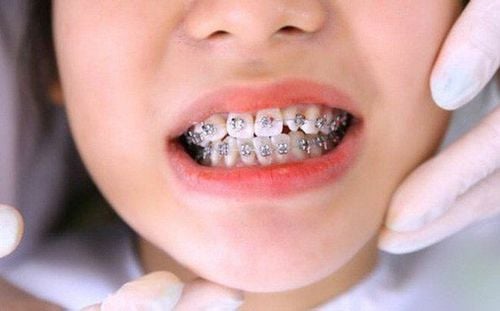This is an automatically translated article.
Each tooth, regardless of position, has the effect of supporting the remaining teeth, helping to bite, tear, chew, grind food and balance facial structure. So what if you lose a permanent tooth or lose a molar? Does missing teeth have any effect on health and aesthetics? The answer is yes, if missing teeth are not treated properly.
1. The role of molars
An adult has a total of 32 standard teeth, divided equally between the upper and lower jaws (each jaw is 16 teeth). The teeth in each jaw are divided into 4 main groups: incisors, canines, premolars and molars.
The incisors group has 8 teeth (called teeth number 1 and 2), including 4 upper molars and 4 lower molars, whose function is to bite and tear food into small pieces. The group of canines has 4 teeth (tooth number 3), each upper and lower teeth have 2, with the main role of clamping and tearing food. The premolar group has 8 teeth (teeth 4 and 5), including 4 upper molars and 4 lower molars, used to tear and crush food. The molar group (molars) has 12 teeth (tooth number 6, 7 and 8, tooth number 8 is also known as wisdom tooth), including 6 upper molars and 6 lower molars. The molars have the main function of chewing and grinding food before it enters the stomach. The sixth tooth, also known as the first molar, is the largest molar that plays an important role in chewing, almost all the chewing force will be on this tooth. Tooth number 6 is also the first permanent tooth on the jaw to erupt, considered the mainstay of future occlusion. If the 6th tooth is misaligned, it will cause the bite to be displaced. The 7th tooth, also known as the 2nd molar, located between the 6th and 8th teeth, is quite large in size and has a complex structure. Tooth number 7 has many roots and many canals. Tooth number 7 in the lower jaw will usually have 2 roots, while tooth number 7 in the upper jaw has up to 3 roots and each root has up to 3 canals. Because of the structure of many roots and many canals, the treatment of missing tooth number 7 will be very complicated. Tooth number 8, also known as wisdom tooth, is the innermost molar, which may or may not erupt and also has no important role.
7 teeth begin to grow permanently at 12 years old, and 6 teeth erupt at about 6-7 years old, when no baby teeth have been replaced. Each permanent molar only erupts once, so if a permanent tooth is lost, it will not grow back.
2. Causes of loss of molars
There are many different causes of molar loss.
2.1. Poor oral hygiene Lazy brushing, improper oral hygiene or not flossing every day in the long run will cause tooth decay, gingivitis and tooth loss.
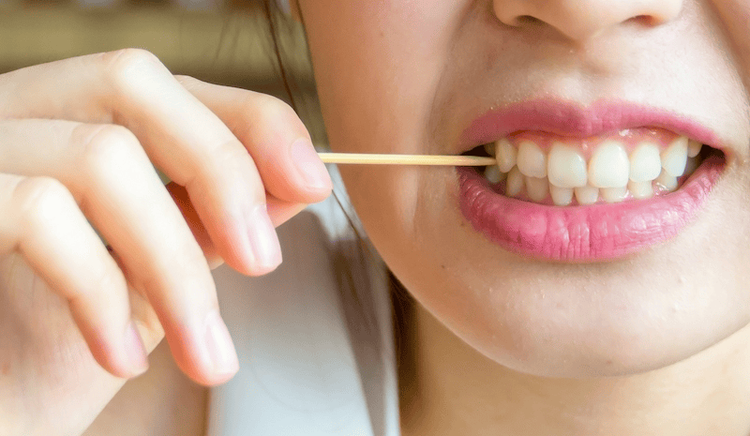
Vệ sinh răng miệng kém có thể gây viêm nướu và mất răng vĩnh viễn
2.2. Improper nutrition Diet lacking nutrients for teeth, especially calcium, is the leading cause of teeth loss. In addition, eating a lot of foods containing sugar, acids and carbohydrates also damages tooth enamel and gums, leading to tooth loss.
2.3. Bad habits Bad habits such as grinding teeth for a long time will cause tooth wear and adversely affect the tooth structure. Smoking is also a cause of worsening gingivitis, which can easily lead to tooth loss.
2.4. Oral trauma Injuries caused by accidents or injuries while playing sports such as martial arts, soccer, basketball,... are very easy to impact on the jawbone and teeth, causing broken teeth or broken teeth if not worn. jaw guard.
2.5. Due to age All activities of teeth such as biting, chewing and grinding food for a long time will wear down the enamel layer and the edges of the teeth, leading to aging. The aging of teeth is more severe in the elderly, making teeth no longer strong and causing tooth loss.
2.6. Not having regular dental check-ups Not having regular dental check-ups, so it is impossible to detect and have timely treatment methods for dental diseases, as well as not to scrape tartar is one of the causes leading to tooth loss.
2.7. Other diseases People with diabetes, arthritis, bite cancer... make teeth weaker and easier to fall out than normal people.
3. Consequences of losing molars
Because they are large teeth, taking on the role of chewing and grinding food, as well as supporting the jawbone structure, molars are very important. So, if a person loses teeth, will there be any impact, especially if he loses his lower teeth or loses his upper teeth? The answer is yes, because the loss of molars will leave many serious consequences.3.1 Makes it difficult to chew and crush food The structure of each person's teeth is inherently stable, so if even one is missing, it will make eating and drinking very inconvenient.
Loss of molars makes eating very difficult, weak chewing and crushing force will prevent food from being crushed thoroughly before entering the digestive system. This has a negative effect on the stomach and intestines. Loss of molars causes food to fall into the gap, resulting in the need to always adjust food to get into the place where teeth are not lost. Losing molars will create a large gap on the jaw, making the adjacent teeth at risk of shifting, leaning, even affecting the entire chewing system. 3.2 Impact on pronunciation Loss of molars can also make pronunciation less accurate and rounder, affecting communication as well as daily work.

Mất răng vĩnh viễn có thể ảnh hưởng tới khả năng phát âm
3.3 Adverse effect on aesthetics Losing molars, although not as aesthetically pleasing as incisors, causes the jaw arch to be out of balance, the cheeks are sunken in, the skin on the side of the missing teeth is sagging and the skin around the mouth is also lost. Many wrinkles appear, making the face look much older than the real age. Over time, if untreated molars are lost, the face can be misaligned, severely affecting aesthetics, leading to feelings of shyness and inferiority when communicating.
3.4 Causes many dental diseases The gaps at the lost tooth site are a favorable environment for harmful bacteria to grow and develop, leading to diseases such as tooth decay, periodontitis, gingivitis , inflammation of the roots and also harm the remaining teeth.
3.5 Causes dangerous complications such as temporomandibular joint pain, bone loss When missing molars, if not restored soon, it can lead to gum recession and jaw bone loss. Losing molars makes the surrounding teeth no longer support, thereby causing great pressure on the jaw, causing jaw muscle pain, temporomandibular joint pain, headache, neck pain. The teeth on the side tend to move into the space of the missing molar, the opposing teeth will also recede or protrude excessively. In the long run, if left untreated, it can cause bite problems. Mild cases can lead to malocclusion, while severe cases can lead to paralysis of both jaw muscles and facial dislocation.
4. Measures to overcome the loss of molars
Today, with advances and modern technology in the field of dentistry, the question of whether it is okay to lose a permanent tooth or lose a molar will no longer be a worry. Even missing teeth can create a favorable opportunity for the teeth to move into the desired beautiful position, helping to shorten the time and achieve the effect of braces.
Denture implant is currently the best solution to overcome the loss of molars as well as prevent the consequences that can be caused by the loss of molars. Currently, there are two methods of implantation and restoration of teeth: dental implants and porcelain bridges.
4.1 Dental Implant Implant is a method of planting fixed dentures to replace 1 or more teeth. This technique is performed by implanting an artificial tooth root made of Titanium into the jaw bone, coupling with the Abutment above to act as a bridge abutment, then attaching the prosthetic porcelain tooth to the Implant post.
The advantages of dental implants are:
Replanted teeth have roots, crowns, and crowns, so they are very solid and highly aesthetic. Because the outer surface of the implant will integrate with the jaw bone, helping the dentures have a firm grip, so the chewing ability is restored and there is no fear of falling or shifting the teeth during chewing and biting. . In addition, the natural tooth root is replaced by the Implant post, so it does not cause gum atrophy, bone destruction, jaw bone loss, etc. Implant does not need to grind real teeth, so it does not affect the next teeth. approach as the method of making a tooth bridge. The average lifespan of dental implants is more than 20 years, even if you take good care of your oral health, it will last almost forever. The disadvantage of the implant method is
The treatment cost is quite high. It cannot be done for people with diabetes or severe hypertension, patients undergoing chemotherapy or radiation therapy, people with Abnormal bone structure.
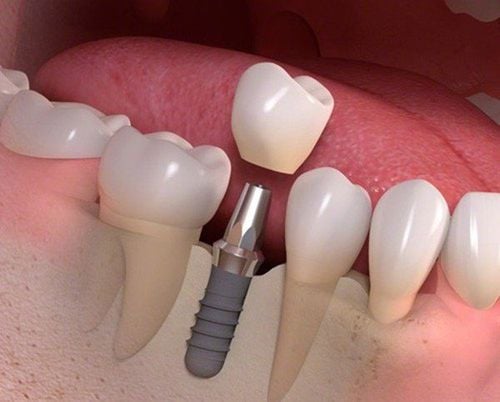
Người bị mất răng vĩnh viễn có thể trồng răng Implant
4.2. Porcelain dental bridge Porcelain bridge is a method of implanting false teeth to replace one or more successively missing teeth. The bridge is fixed to a real tooth below with dental glue. The two real teeth on either side of the missing tooth will be ground to make a pillar for the porcelain bridge, helping the bridge to stand firmly on the jaw. Porcelain bridges are also a measure to overcome the loss of molars, but the effect after implantation is not appreciated compared to implant teeth.
The advantages of porcelain bridges are:
The ability to chew and aesthetic is higher than using removable dentures. Short treatment time. The material used to make dentures is safe for the body, so it can be applied to people with diabetes, high blood pressure,... Disadvantages of porcelain dental bridges are:
Causes damage to the abutment teeth due to 2 adjacent real teeth. abraded edges to make piers. Teeth that are grinded will bear weaker forces, are more susceptible to damage than other teeth, and are also more susceptible to oral diseases. In addition, if the two abutments are not ground in the correct ratio, it will lead to tooth wear, tooth abscesses, pulpitis,... Jaw bone loss. Making a porcelain bridge, although maintaining the basic chewing functions of the teeth and aesthetics, but because there is no tooth root to create chewing force affecting the jaw bone, it cannot prevent the process of gum loss, jaw bone loss, etc. for a long time make the face deform. The loss of jaw bone will cause the surrounding teeth to be displaced towards the gap, the teeth on the opposite side will also emerge, causing an imbalance of the teeth. Porcelain bridge is placed above the gums, there is no root but only fixed by 2 abutments, so food is easy to get caught in the small gap between the porcelain teeth and gums, causing gingivitis, periodontitis... - Jaw - Face - Vinmec International General Hospital specializes in examining and treating all common dental problems in adults and children. The hospital has a team of qualified doctors and dentists and a system of advanced machinery to help support the examination process well and shorten the time.
Therefore, when there is any problem, you can go to the hospital to be checked for appropriate instructions from a specialist doctor. Avoiding leaving for a long time will affect the structure and aesthetics of the teeth.
Please dial HOTLINE for more information or register for an appointment HERE. Download MyVinmec app to make appointments faster and to manage your bookings easily.




